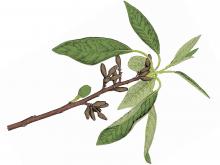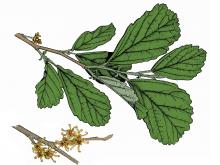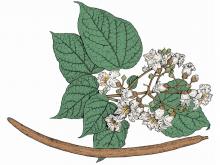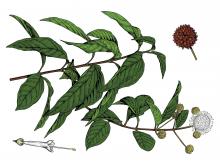Trees, Shrubs and Woody Vines
Media

Species Types
Scientific Name
Quercus imbricaria
Description
Shingle oak got its name because the naturalist who discovered it noticed that French colonists in Illinois were using the wood to make roofing shingles. The leaves resemble those of laurel (bay), lacking lobes or teeth — but laurel trees don't bear acorns!
Media

Species Types
Scientific Name
Leitneria floridana
Description
Corkwood is a rare and unusual small tree that doesn’t have a problem with having its feet wet for long periods of time, but it grows rarer as its swampy habitat is converted to cropland.
Media

Species Types
Scientific Name
Rhus spp.
Description
Sumacs are shrubs or small trees that often form colonies from their creeping, branched roots. The foliage usually turns brilliant shades of red in early autumn. The clusters of berrylike fruits are red.
Media

Species Types
Scientific Name
Cornus alternifolia
Description
Dogwoods usually have leaves arranged opposite one another on the stem, except for the alternate-leaved dogwood! This shrub or small tree is a popular ornamental, especially in the northern parts of Missouri, where it can be too cold to grow flowering dogwood.
Media

Species Types
Scientific Name
Cornus amomum
Description
Swamp dogwood, or silky dogwood, grows nearly statewide in wet locations. Recognize it by its reddish-brown or dark brown young branchlets and blue, berrylike fruit, conspicuous in late fall.
Media

Species Types
Scientific Name
Cornus spp.
Description
Missouri’s five species of dogwoods are shrubs or small trees with distinctive flowers, fruits, and bark. The fruits may be red, white, or blue. The leaves have characteristic arching veins.
Media

Species Types
Scientific Name
Hamamelis vernalis
Description
Ozark witch-hazel is a large native shrub that grows along dry, rocky streambeds in southern and east-central Missouri. The yellow, ribbonlike flowers bloom as early as January. In the fall, the seeds are ejected forcefully, to a distance of up to 30 feet!
Media

Species Types
Scientific Name
Magnolia acuminata
Description
Cucumber magnolia is an impressive, large, broad-spreading shade tree native to southern Missouri. It is often cultivated in the eastern United States because, compared to more southern magnolias, it is relatively cold-hardy.
Media

Species Types
Scientific Name
Catalpa speciosa
Description
Of the three species of catalpas in our state, northern catalpa is the only one native to Missouri (specifically, the Bootheel region). It has been planted widely, though, and has naturalized in many places. A popular ornamental and shade tree with pretty, orchidlike flowers and long, beanlike fruit.
Media

Species Types
Scientific Name
Cephalanthus occidentalis
Description
White flowers clustered in round balls give buttonbush its name. It's always found near water, and thickets of buttonbush help protect lakeshores from wave action. This shrub is also planted as an ornamental.
See Also
About Trees, Shrubs and Woody Vines in Missouri
There are no sharp dividing lines between trees, shrubs, and woody vines, or even between woody and nonwoody plants. “Wood” is a type of tissue made of cellulose and lignin that many plants develop as they mature — whether they are “woody” or not. Trees are woody plants over 13 feet tall with a single trunk. Shrubs are less than 13 feet tall, with multiple stems. Vines require support or else sprawl over the ground.





















